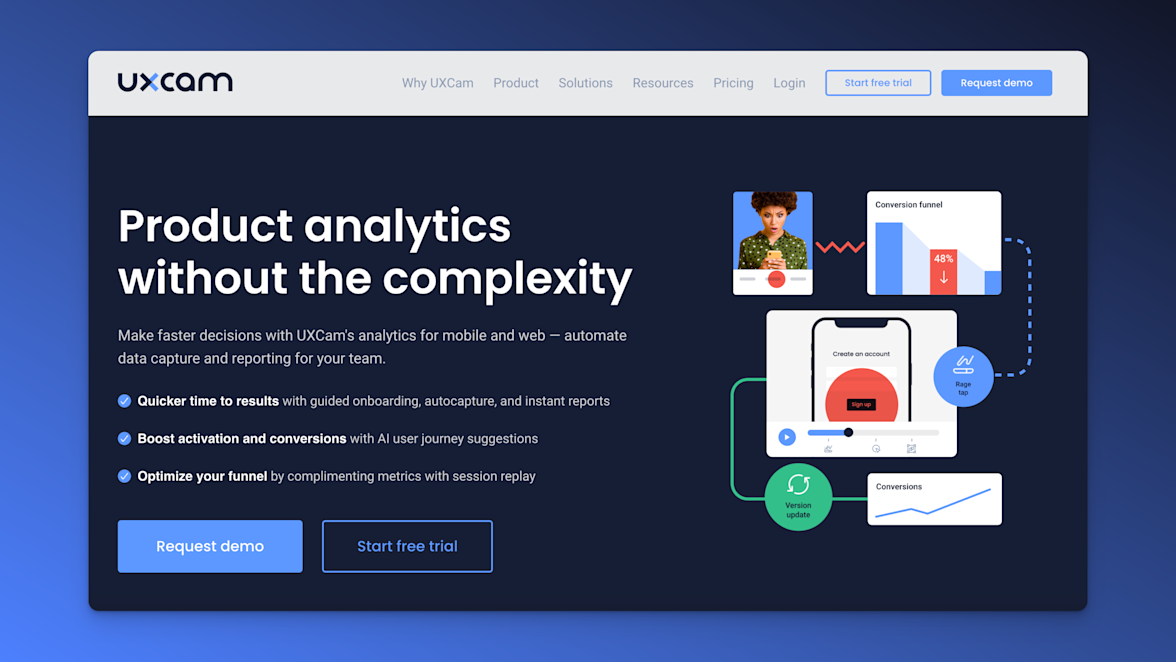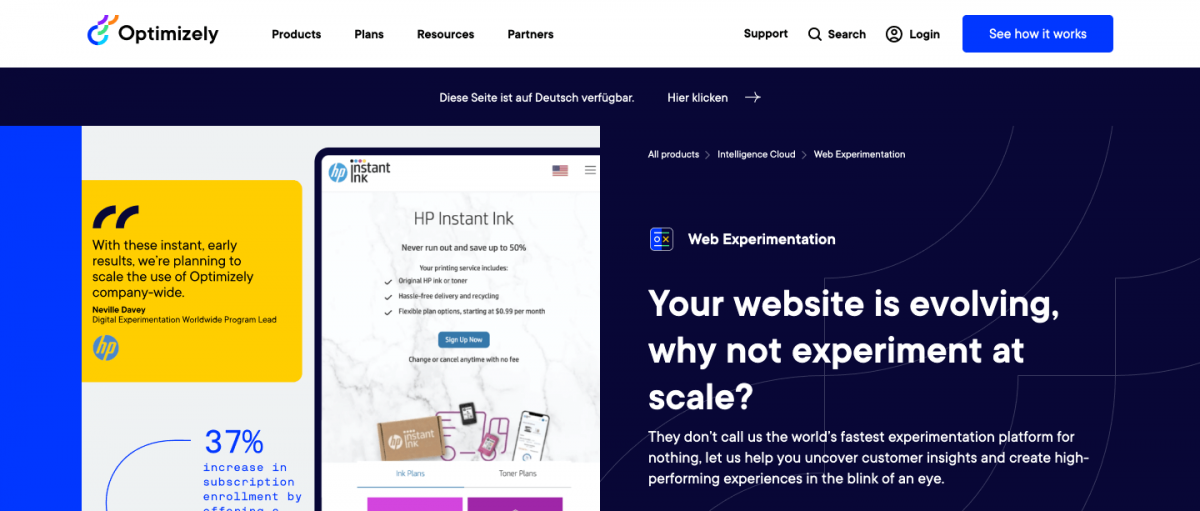AI Conversion Rate Optimization - What It Is & How It Works
PUBLISHED
8 May, 2025

Growth Marketing Manager
Improving your website’s performance can feel like shooting in the dark. You might spend weeks running A/B tests, analyzing heatmaps, and tweaking layouts—only to see marginal gains.
Traditional conversion rate optimization (CRO) is slow, manual, and often driven by gut feeling rather than real-time data.
Enter AI conversion rate optimization - a more innovative, faster way to uncover what’s working and what’s not.
By leveraging machine learning and behavioral data, AI removes the guesswork and speeds up decision-making. It predicts outcomes, personalizes user journeys, and helps you confidently scale improvements.
In this guide, we’ll explain how AI is transforming CRO, which tools to consider, and how to start using them right now. Whether you’re just starting out or looking to sharpen your strategy, you’ll leave with actionable insights and proven techniques to boost performance.
Summary - AI in conversion rate optimization
| Aspect | Details |
|---|---|
| Definition | AI Conversion Rate Optimization (AI CRO) refers to the practice of applying machine learning and automation techniques to increase the conversion rate of a website, app, or landing page. |
| Goal | Maximize user actions that generate business value (e.g. purchases, signups, demos) without increasing traffic. |
| Key Difference from Traditional CRO | Traditional CRO relies on manual A/B testing and heuristic analysis. AI CRO uses algorithms to dynamically personalize, test, and adapt user experiences in real-time. |
AI CRO tools ingest user interaction data and use it to:
Identify friction points: via heatmaps, click tracking, rage clicks, exit intent, and session replays.
Segment users: using clustering models based on behavior, intent, or demographics.
Personalize experiences: like showing different CTAs, layouts, or offers based on real-time predictions.
Optimize variants: through multivariate testing and reinforcement learning (e.g. bandit algorithms).
What is AI conversion rate optimization (CRO)?
AI Conversion Rate Optimization (AI CRO) is the use of artificial intelligence to automatically analyze user behavior, test variations, and optimize digital experiences to increase the percentage of visitors who take a desired action, such as signing up or purchasing.
Conversion Rate Optimization (CRO) is improving your website or app so more users take a desired action, like signing up, purchasing, or completing a form.
Instead of guessing what users want, CRO helps you experiment and make data-backed improvements that nudge people toward conversion.
Traditionally, CRO has relied on methods like:
A/B testing: Comparing two page versions to see which performs better.
User research: Surveys, interviews, or usability tests to understand friction points.
Heatmaps: Visual representations of where users click, scroll, or get stuck.
These methods help uncover problems, but they’re slow and labor-intensive.
Plus, interpreting the data correctly requires experience. Tools like Optimizely have helped marketers run tests, but most still require manual setup, hypothesis building, and result analysis.
That’s where AI accelerates and scales what CRO can do.
How AI Is Transforming CRO
Artificial intelligence is changing the game for CRO by eliminating guesswork and accelerating decisions.
Instead of manually running experiments and combing through spreadsheets, AI tools analyze and act on user behavior in real time.
Here’s how AI enhances conversion rate optimization:
Predictive Analytics: Based on historical data, AI forecasts which changes are most likely to impact conversions.
Real-Time Personalization: Pages and experiences are adapted instantly to match each user’s preferences or behavior.
Automated Testing: AI runs multivariate tests automatically, identifying top-performing combinations without constant manual input.
Behavior Pattern Recognition: AI spots trends like rage taps, hesitation, or drop-offs—faster than any human can.
A recent McKinsey study found that 35% of companies are using AI in marketing and sales, with CRO being a top application for improving customer journeys and increasing ROI.
The result? Faster learning cycles, more personalized UX, and scalable insights that drive measurable results, especially when integrated with tools like UXCam for user behavior analytics.

Benefits of AI in CRO
AI is a powerful accelerator for teams that want to improve conversions without spending months testing manually. Here's why AI has become a go-to tool for modern CRO strategies:
Faster Experimentation Cycles: AI can analyze user behavior and test multiple variants at once. This means more experiments, less waiting, and quicker insights.
Hyper-Personalized UX: AI adapts content, layouts, and offers based on each visitor’s real-time behavior, location, device, or past interactions—there is no need for guesswork.
Improved ROI and Smarter Decisions: Because AI analyzes vast amounts of behavioral data, it provides recommendations grounded in evidence, not assumptions. The result? Higher conversion rates and better ROI.
Scalability for Businesses of Any Size: Whether you’re a startup or an enterprise, AI allows you to run advanced CRO experiments without hiring a massive analytics team.
Backed by Data: According to Salesforce’s State of Marketing report, 68% of high-performing marketers use AI to improve customer experiences, including personalization and predictive targeting.
Use Cases: Real-world examples of AI CRO in action
To make it real, here’s how AI-powered CRO plays out across industries and platforms:
E-commerce personalization with AI
AI helps online retailers show dynamic product recommendations based on previous browsing behavior, purchase history, and even device type. Tools like Dynamic Yield and Shopify’s built-in AI features enable this at scale, improving both cart value and checkout rates.
SaaS onboarding optimization
In SaaS, the first-time user experience can make or break conversions. AI can personalize onboarding flows by detecting drop-off points and adapting the experience for different user segments. This reduces churn and increases trial-to-paid conversion.
Mobile app experience improvements
AI identifies patterns like screen exits, rage taps, and UI friction points. Combined with session replays and heatmaps from UXCam, teams can diagnose why users abandon a flow and then test changes that lead to measurable improvements.
Introducing Tara AI – Your always-on analyst
You’re sitting on a goldmine of session replays—but buried insights aren’t helpful. Why are users rage tapping on the login screen? Why do they abandon halfway through onboarding? You don’t have time to watch every session.
Tara AI does. Tara is your always-on, AI-powered analyst that watches every user interaction, detects patterns, and flags the moments that matter—instantly. No more guesswork. No more hours lost in footage. Just clear, prioritized insights and practical recommendations your team can act on today.
Signup for FREE to try Tara AI and turn raw behavior into confident decisions—without lifting a finger.
How to implement AI CRO on your website
You don’t need to overhaul everything to start using AI for conversion rate optimization. A few strategic steps can help you integrate AI into your existing workflow and start seeing results faster.
1. Set clear conversion goals
Before anything else, define what success looks like.
Is it more signups? Higher checkout rates? Better onboarding completion? Having a clear goal helps AI tools know what to optimize for and how to evaluate success.
2. Integrate behavioral analytics
AI is only as good as the data you feed it. That’s why behavioral analytics tools like UXCam are foundational. They track real user interactions—taps, swipes, rage clicks, exits—and give your CRO platform the behavioral context to make wise decisions.
3. Use AI-powered testing tools
Replace manual A/B testing with AI tools that can run multivariate tests automatically. These tools learn over time and adjust the traffic distribution to prioritize high-performing variants, reducing wasted time and traffic.
4. Segment audiences based on behavior
AI can help you create smart segments automatically—first-time users, returning visitors, high-intent buyers, or users who rage-tap. You can then tailor the experience for each group to boost conversions.
5. Automate insights and rollouts
Let AI surface recommendations based on user patterns, and automate the rollout of winning changes. With the right setup, you can continuously improve UX and performance without a manual review.
Top AI Tools for conversion rate optimization
Here’s a curated list of AI tools that are leading the charge in CRO, each with their own strengths:
1. UXCam

Best for: AI-powered session replay and user behavior insights Why it matters: UXCam doesn’t just record sessions—it watches them for you. Its built-in AI analyzes user sessions to surface patterns like rage taps, drop-offs, and crashes automatically. This gives product teams immediate clarity on where users struggle. When combined with AI CRO tools, UXCam becomes the behavioral source of truth that drives smarter experiments, faster fixes, and higher conversions.
2. Dynamic Yield
Best for: E-commerce personalization at scale Pros: AI-driven product recommendations, real-time personalization Cons: Enterprise pricing, longer setup for complex use cases
3. Convert.com

Best for: Privacy-focused, developer-friendly A/B testing Pros: Strong privacy compliance (GDPR), great for technical teams Cons: Less intuitive for marketers without dev support
4. Mutiny
Best for: B2B website personalization Pros: No-code personalization, strong integrations with CRMs like Salesforce Cons: Limited to website optimization (not mobile apps)
5. Optimizely

Best for: Enterprise experimentation and digital experience platforms Pros: Advanced testing features, built-in AI for traffic allocation Cons: Higher learning curve, expensive for smaller teams
Framework: The AI-driven CRO process
Implementing AI in CRO doesn’t have to be overwhelming. Use this five-step framework to build a consistent and scalable optimization process:
1. Capture behavioral data
Start by collecting data on how users interact with your site or app. Tools like UXCam capture gestures, session flows, rage taps, and exits—all of which form the behavioral foundation AI needs to make informed decisions.
2. Analyze with AI
AI algorithms analyze the data to uncover patterns. You might discover that users from a certain traffic source abandon at the same step, or that mobile users rage-tap on a specific button. These insights are faster and more precise than human analysis alone.
3. Hypothesize based on insights
Use AI-surfaced insights to form smart, testable hypotheses. For example, if users abandon a pricing page quickly, the hypothesis might be: “The pricing layout is overwhelming and needs simplification.”
4. Test automatically
Feed those hypotheses into your AI-powered CRO tool. It can run multivariate or personalization tests automatically, shifting traffic toward what’s working best without waiting on human intervention.
5. Scale and optimize
Once you’ve validated a winning variant, scale it to all relevant audiences. Then, continue the cycle—new data brings new insights, and your optimization process never stops improving.
Common mistakes to avoid in AI CRO
Even with powerful tools, AI CRO isn’t plug-and-play. Here are the pitfalls that can hurt your performance—and how to avoid them:
Over-Reliance on Automation Letting AI do all the work without any human oversight can backfire. Use AI to accelerate decisions, not replace critical thinking.
Ignoring Qualitative Data Quantitative insights are powerful, but they don’t tell the full story. Session replays, user interviews, and open-ended survey responses provide valuable context.
Not Validating AI Recommendations Just because the AI suggests a change doesn’t mean it’s right. Always validate key decisions with a sample audience or a controlled test group before a full rollout.
Not Testing on Mobile Mobile traffic is often more than 50% of total users. If you’re not testing your CRO changes on mobile, you’re flying blind. Tools like UXCam help you understand mobile-specific behavior and performance issues.
Avoiding Help When It’s Needed Many businesses continue struggling with poor conversions instead of collaborating with an experienced AI marketing agency that could help unlock data-driven solutions, fast. Knowing when to bring in outside expertise can save both time and money.
Conclusion
AI conversion rate optimization is no longer a luxury—it’s a competitive advantage. By automating tedious tasks, uncovering deep user insights, and personalizing experiences at scale, AI helps businesses drive measurable improvements faster than ever before.
Whether you’re just starting with CRO or looking to level up, the combination of AI tools and behavioral analytics platforms gives you the clarity and speed needed to make high-impact changes. From understanding user frustration to automating winning experiences, AI makes every test more innovative—and every result more actionable.
Want to see what AI CRO could look like on your mobile app or website? Start by exploring UXCam’s analytics features or sign up for a free trial to uncover friction points and turn them into conversion wins.
FAQs
What is AI conversion rate optimization?
AI conversion rate optimization uses artificial intelligence and machine learning to analyze user behavior, predict outcomes, and automate testing—helping businesses improve conversions faster and more efficiently than manual methods.
Do I need coding skills to use AI CRO tools?
Not necessarily. Many modern CRO platforms offer no-code or low-code options that allow marketers and product teams to run experiments without technical help.
Is AI CRO only for big businesses?
No. While enterprise brands were early adopters, many AI CRO tools now offer pricing and features suitable for startups and small teams. The scalability of AI makes it accessible at any stage.
How does UXCam support AI CRO efforts?
UXCam provides detailed behavioral insights through heatmaps, session replays, rage tap detection, and crash analytics. This data feeds directly into your AI CRO tools to inform smarter testing and more personalized user experiences.
What’s the difference between AI CRO and traditional A/B testing?
Traditional A/B testing compares two versions at a time and requires manual setup and analysis. AI CRO can run multivariate tests, adapt traffic allocation in real time, and surface insights automatically, making it significantly faster and more scalable.
You might also be interested in these;
How to Find Unique Monthly Visitors For a Website
E-commerce customer analytics - How to drive growth with data
Ecommerce Conversion Rate Optimization (CRO) - Ultimate Guide
Product Performance Analysis - A 7-Step Playbook with UXCam
Ecommerce product management guide for mobile product teams
Top 5 best e-commerce analytics tools
AUTHOR

Tope Longe
Growth Marketing Manager
Ardent technophile exploring the world of mobile app product management at UXCam.
What’s UXCam?
Related articles
Website Optimization
AI Conversion Rate Optimization - What It Is & How It Works
Boost your website performance with AI Conversion Rate Optimization. Learn how AI tools analyze behavior, personalize UX, and increase conversions...

Tope Longe
Growth Marketing Manager
Website Optimization
10 Best Landing Page Optimization Tools
Boost conversions with the 10 best landing page optimization tools. Compare features, pricing, and use cases for growth-focused...

Tope Longe
Growth Marketing Manager
Website Optimization
How to Improve User Experience on Website
Improve website UX with 10 proven tips for product managers. Learn how to spot issues, reduce friction, and boost conversions using UXCam for...

Tope Longe
Growth Marketing Manager